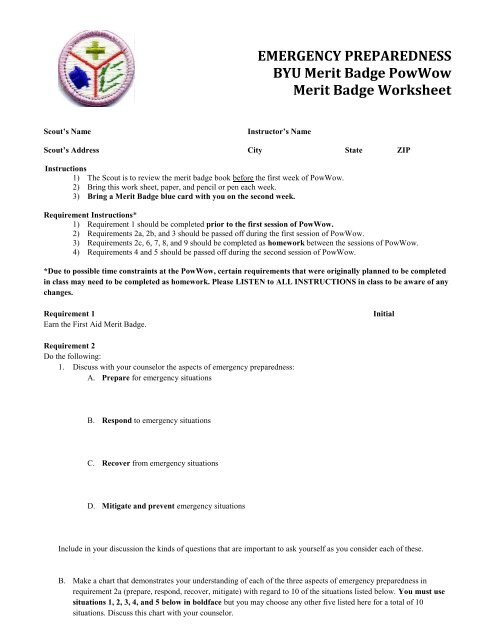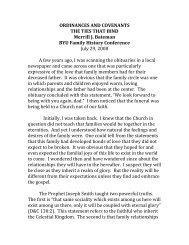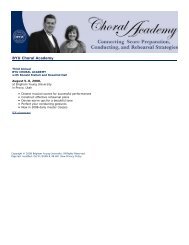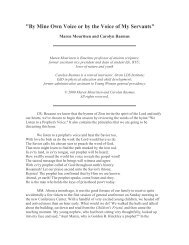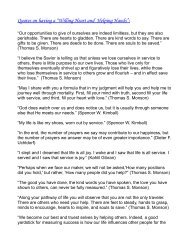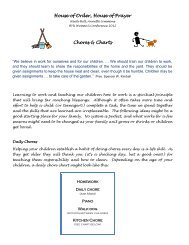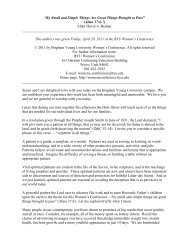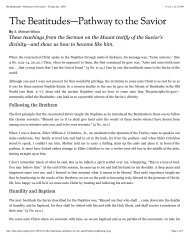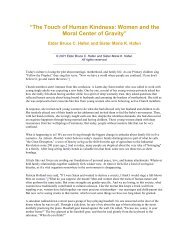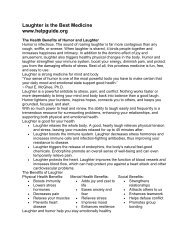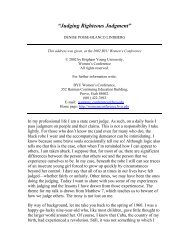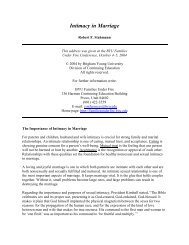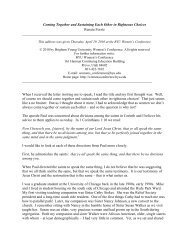EMERGENCY PREPAREDNESS BYU Merit Badge PowWow Merit ...
EMERGENCY PREPAREDNESS BYU Merit Badge PowWow Merit ...
EMERGENCY PREPAREDNESS BYU Merit Badge PowWow Merit ...
Create successful ePaper yourself
Turn your PDF publications into a flip-book with our unique Google optimized e-Paper software.
Scout’s Name Instructor’s Name<br />
<strong>EMERGENCY</strong> <strong>PREPAREDNESS</strong><br />
<strong>BYU</strong> <strong>Merit</strong> <strong>Badge</strong> <strong>PowWow</strong><br />
<strong>Merit</strong> <strong>Badge</strong> Worksheet<br />
Scout’s Address City State ZIP<br />
Instructions<br />
1) The Scout is to review the merit badge book before the first week of <strong>PowWow</strong>.<br />
2) Bring this work sheet, paper, and pencil or pen each week.<br />
3) Bring a <strong>Merit</strong> <strong>Badge</strong> blue card with you on the second week.<br />
Requirement Instructions*<br />
1) Requirement 1 should be completed prior to the first session of <strong>PowWow</strong>.<br />
2) Requirements 2a, 2b, and 3 should be passed off during the first session of <strong>PowWow</strong>.<br />
3) Requirements 2c, 6, 7, 8, and 9 should be completed as homework between the sessions of <strong>PowWow</strong>.<br />
4) Requirements 4 and 5 should be passed off during the second session of <strong>PowWow</strong>.<br />
*Due to possible time constraints at the <strong>PowWow</strong>, certain requirements that were originally planned to be completed<br />
in class may need to be completed as homework. Please LISTEN to ALL INSTRUCTIONS in class to be aware of any<br />
changes.<br />
Requirement 1 Initial<br />
Earn the First Aid <strong>Merit</strong> <strong>Badge</strong>.<br />
Requirement 2<br />
Do the following:<br />
1. Discuss with your counselor the aspects of emergency preparedness:<br />
A. Prepare for emergency situations<br />
B. Respond to emergency situations<br />
C. Recover from emergency situations<br />
D. Mitigate and prevent emergency situations<br />
Include in your discussion the kinds of questions that are important to ask yourself as you consider each of these.<br />
B. Make a chart that demonstrates your understanding of each of the three aspects of emergency preparedness in<br />
requirement 2a (prepare, respond, recover, mitigate) with regard to 10 of the situations listed below. You must use<br />
situations 1, 2, 3, 4, and 5 below in boldface but you may choose any other five listed here for a total of 10<br />
situations. Discuss this chart with your counselor.
1. Home kitchen fire<br />
Situation Prepare Respond Recover Mitigate<br />
2. Home basement/storage<br />
room/garage fire<br />
3. Explosion in home<br />
4. Automobile accident<br />
5. Food-borne disease (food<br />
poisoning)<br />
6. Fire or explosion in a public<br />
place<br />
7. Vehicle stalled in the desert<br />
8. Vehicle trapped in a blizzard<br />
9. Flash flooding in town or the<br />
country<br />
10. Mountain/ backcountry<br />
accident<br />
11. Boating accident<br />
12. Gas leak in a home or a<br />
building<br />
13. Tornado or hurricane<br />
14. Major flood<br />
15. Nuclear power plant<br />
emergency<br />
16. Avalanche (snowslide or<br />
rockslide)<br />
17. Violence in a public place
C. Meet with and teach your family how to get or build a kit, make a plan, and be informed for the situations on the<br />
chart you created for requirement 2b. Complete a family plan. Then meet with your counselor and report on your<br />
family meeting, discuss their responses, and share your family plan.<br />
Requirement 3 Initial<br />
Show how you could safely save a person from the following:<br />
A. Touching a live household electric wire.<br />
B. A room filled with carbon monoxide.<br />
C. Clothes on fire.<br />
D. Drowning using non-swimming rescues (including accidents on ice)<br />
Requirement 4 Initial<br />
Show three ways of attracting and communicating with rescue planes/aircraft.<br />
Requirement 5 Initial<br />
With another person, show a good way to transport an injured person out of a remote and/or rugged area, conserving the<br />
energy of rescuers while ensuring the well-being and protection of the injured person.<br />
Requirement 6 Initial<br />
Do the following:<br />
A. Tell the things a group of Scouts should be prepared to do, the training they need , and the safety precautions they<br />
should take for the following emergency services:<br />
a. Crowd and traffic control.<br />
b. Messenger service and communication.<br />
c. Collection and distribution services.<br />
d. Group feeding, shelter, and sanitation.<br />
B. Identify the government or community agencies that normally handle and prepare for the emergency services listed<br />
under 6a, and explain to your counselor how a group of Scouts could volunteer to help in the event of these types of<br />
emergencies.<br />
C. Find out who is your community's emergency management director and learn what this person does to prepare,<br />
respond to, recover from, and mitigate and prevent emergency situations in your community. Discuss this<br />
information with your counselor and apply what you discover to the chart you created for requirement 2b.
Requirement 7 Initial<br />
Take part in an emergency service project, either a real one or a practice drill, with a Scouting unit or a community agency.<br />
Requirement 8 Initial<br />
Do the following:<br />
a. Prepare a written plan for mobilizing your troop when needed to do emergency service. If there is already a plan,<br />
explain it. Tell your part in making it work.<br />
b. Take part in at least one troop mobilization. Before the exercise, describe your part to your counselor. Afterward,<br />
conduct an "after-action" lesson, discussing what you learned during the exercise that required changes or<br />
adjustments to the plan.<br />
c. Prepare a personal emergency service pack for a mobilization call. Prepare a family kit (suitcase or waterproof<br />
box) for use by your family in case an emergency evacuation is needed. Explain the needs and uses of the<br />
contents.<br />
Requirement 9 Initial<br />
Do ONE of the following:<br />
a. Using a safety checklist approved by your counselor, inspect your home for potential hazards. Explain the<br />
hazards you find and how they can be corrected. Attach the sheet to this worksheet to show your counselor.<br />
b. Review or develop a plan of escape for your family in case of fire in your home.<br />
c. Develop an accident prevention program for five family activities outside the home (such as taking a picnic or<br />
seeing a movie) that includes an analysis of possible hazards, a proposed plan to correct those hazards, and the<br />
reasons for the corrections you propose.<br />
<strong>Merit</strong> badge work sheets will not be accepted at the Council Office in place of the official <strong>Merit</strong> <strong>Badge</strong> Application<br />
Card. Those who do not complete all the requirements should take their partially completed merit badge work sheet<br />
and their official application card to their local merit badge counselors for completion.
Sample Home Safety Checklist<br />
Sample Checklist for Requirement 9 a. Check safety steps that being taking in your home. Write N/A if the item is not<br />
applicable. Items left blank may present a safety hazard. This list provides some sample safety steps you might take. See your<br />
Safety <strong>Merit</strong> <strong>Badge</strong> pamphlet and counselor for more information. Ask your parent or guardian before making any changes.<br />
Stairways, Halls, and Outdoor Steps<br />
___ Stairways with three or more steps have a strong<br />
handrail.<br />
___ Stairs/halls are kept free from boxes, toys, brooms,<br />
tools, etc.<br />
___ Gates at top and bottom of stairs prevent children<br />
from falling.<br />
___ The head and foot of stairs have no small or loose<br />
rugs.<br />
___ Stair carpeting or covering is fastened securely.<br />
___ Stairways & halls have good lighting, controllable at<br />
each end.<br />
Kitchen<br />
___ Matches are kept where children cannot get them.<br />
___ Knives & sharp instruments are kept in knife drawers<br />
or holder.<br />
___ Can openers don't leave sharp edges on cans.<br />
___ Disinfectants & cleaning products are out of reach of<br />
children.<br />
___ Pan handles are turned away from stove edges.<br />
___ Spilled grease, water, or bits of food are wiped up<br />
immediately.<br />
___ Pot holders are within easy reach.<br />
___ A fire extinguisher is mounted near the stove.<br />
Bathroom<br />
___ Tub and shower are equipped with strong handholds.<br />
___ Tub floor has non-slip surface.<br />
___ Poisons are marked, sealed shut, and out of reach of<br />
children.<br />
___ Medicines are out of reach of children in childproof<br />
containers.<br />
___ No one takes medicine in the dark.<br />
Attic and Basement<br />
___ Ladder is strong, solid, and sturdily constructed.<br />
___ Stairway is sturdy and well lighted.<br />
___ Children keep skates and play gear in a specific<br />
place.<br />
___ Walls and beams are free from protruding nails.<br />
___ Fuses or circuit breakers are the proper size.<br />
___ Rubbish & flammable materials are in covered metal<br />
cans.<br />
___ Wastepaper is kept away from furnace and stairs.<br />
Living Room and Dining Room<br />
___ Furniture is placed to allow easy passage in an<br />
emergency.<br />
___ Before bedtime, furniture placement is checked for<br />
orderliness.<br />
___ Furniture and woodwork solid, in good repair, and free<br />
from.<br />
___ Fireplace screen fits snugly.<br />
___ Rugs are fastened or laid on non-slip pads.<br />
___ Rugs are kept from curling at their edges.<br />
___ Wax on floors is thoroughly buffed.<br />
___ Fire in fireplace is extinguished at bedtime.<br />
___ Candles are in stable holders and fully extinguished<br />
after use.<br />
Bedroom<br />
___ Smoke alarm has fresh battery or electrical<br />
connection & is tested regularly.<br />
___ Carbon monoxide detector has fresh battery or<br />
electrical connection and is tested regularly.<br />
___ Furniture placement for clear passage between bed<br />
and door.<br />
___ Light switch or lamp is within easy reach from bed.<br />
___ A night-light illuminates bedroom or hall.<br />
___ Bureau and dresser drawers are closed when not in<br />
use.<br />
___ Bar across bunk beds helps prevent falls.<br />
___ Children are taught not to lean against windows or<br />
screens.<br />
___ Sturdily screen low windows to prevent children from<br />
falling.<br />
___ Smoking in bed is prohibited.<br />
___ Gas and electric heating devices are turned off at<br />
bedtime.<br />
Nursery<br />
___ Bars on cribs are closely spaced.<br />
___ Crib is approved by Consumer Products or similar.<br />
___ Crib is free from sharp edges or corners.<br />
___ Sleeping garments and covers keep baby warm<br />
without<br />
danger of smothering.<br />
___ Pillows are kept out of bassinet or crib.<br />
___ No thin, plastic material is in or near the crib.<br />
___ Children are taught not to give marbles, etc. to<br />
younger<br />
children.<br />
___ Toys are sturdy & have no sharp edges.<br />
___ Nontoxic paint is used on baby furniture and toys.<br />
___ All houseplants are nonpoisonous.
Stoves, Furnaces, and Heaters<br />
___ Stoves are away from curtains.<br />
___ Stoves & furnaces are inspected & cleaned annually.<br />
___ Gas burners are properly adjusted and free from<br />
leaks.<br />
___ Gas water and space heaters are equipped with vents<br />
or flues.<br />
___ Water heater or boiler has a safety valve & is checked<br />
yearly.<br />
___ Flames of gas burners are protected from drafts.<br />
___ Insulating shield protects woodwork within 18” of<br />
furnace, etc.<br />
___ Keep flammable materials away from stoves,<br />
furnaces, etc.<br />
___ A wrench is stored near the shut-off valve of outside<br />
gas line.<br />
Porch, Yard, and Garage<br />
___ Railings and banisters are sound and inspected<br />
periodically.<br />
___ Steps and walks are kept free from ice and snow.<br />
___ Yard/play space are free from holes, stones, glass,<br />
etc.<br />
___ Tools and dangerous articles are out of reach of<br />
children.<br />
___ Dangerous products & chemicals are kept in original<br />
containers<br />
in locked storage areas.<br />
___ Wires and low fences are brightly painted or clearly<br />
marked.<br />
___ Wells, cisterns, and pits are kept securely covered.<br />
___ Disposable materials are not burned outside.<br />
___ An area is marked off in the garage for bicycles,<br />
wagons, etc.<br />
___ Lawn mower is equipped with proper safeguards.<br />
Workshop<br />
___ Good ventilation exists, especially when sanding.<br />
___ Safety goggles and/or face mask are available, with<br />
eyewash.<br />
___ Baking soda is kept handy to neutralize acid burns.<br />
___ All electrical tools are either three-wire or doubleinsulated.<br />
___ Work area is well lit & free of clutter, scraps, rags.<br />
___ All tools have a place & are in their place.<br />
___ Guards are in place on all power tools.<br />
___ A push stick is available for use with power saws.<br />
Electrical Devices and Fixtures<br />
___ Electrical fixtures and appliances are located & used<br />
beyond arm's length of the sink, stove, tub, shower, or<br />
other grounded metal unless outlet is protected by a<br />
ground-fault interrupter.<br />
___ Do not touch electrical fixtures or appliances with wet<br />
hands.<br />
___ Disconnect seldom-used appliances when not in use.<br />
___ All pull-type sockets have an insulating link.<br />
___ Household appliances are disconnected before<br />
repairs.<br />
___ Unused, open, screw-type sockets are plugged<br />
closed.<br />
___ Frayed or worn electric cords are promptly replaced.<br />
___ Long trailing cords are not in evidence.<br />
___ Cords are kept out from under rugs, doors, and<br />
furniture.<br />
___ UA-approved extension cords are the proper size.<br />
___ Children are taught never to touch electric sockets or<br />
fixtures.<br />
___ Fuses are adequate for the load and are not<br />
bypassed.<br />
___ Circuit breakers are not overloaded.<br />
General<br />
___ At least one smoke detector in each bedroom &<br />
garage.<br />
___ Everything has a place and is in its place.<br />
___ Stepladders are in good repair and stored out of the<br />
way.<br />
___ Window screens and storm windows are securely<br />
fastened.<br />
___ Guns are stored unloaded and in locked cases.<br />
___ Guns and ammunition are stored separately.<br />
___ Children are permitted to use only blunt-end scissors.<br />
___ Housework clothing has no drooping sleeves, sashes,<br />
or frills.<br />
___ Shoes worn for housework have low heels.<br />
___ All shoes are in good repair.<br />
___ Kerosene, gasoline, paint thinners, and other volatile<br />
materials are stored outside in special, clearly marked<br />
metal containers.<br />
___ Oil mops, dust rags, painting equipment, and other<br />
oily materials are stored outside in open metal containers.<br />
___ Everyone turns on a light before entering a dark room.<br />
___ Matches are extinguished before they're thrown away.<br />
___ Children are never permitted to play with matches.<br />
___ Fire extinguishers are readily available.<br />
For Emergency<br />
___ Know how to get emergency help (911, poison<br />
control, etc.).<br />
___ Be able to find water, gas, & electric shutoffs. Check<br />
annually.<br />
___ First aid kit approved by your doctor/American Red<br />
Cross.<br />
___ Know basic first aid procedures.<br />
___ Have a fire escape plan from your home.<br />
___ Emergency water supply.<br />
___ Handheld flashlights readily available.<br />
___ In earthquake-prone areas, make sure that the


